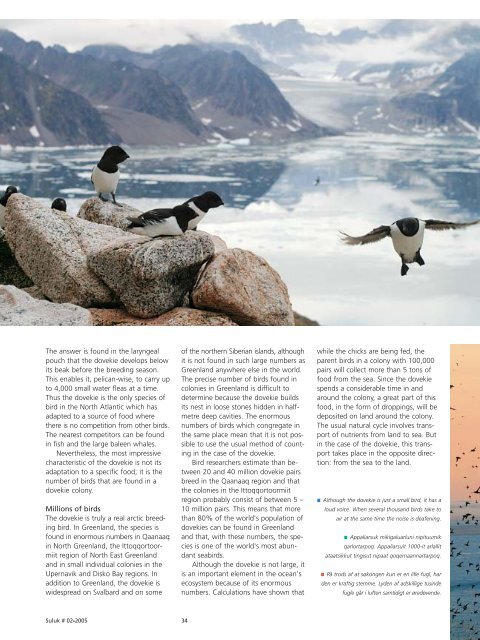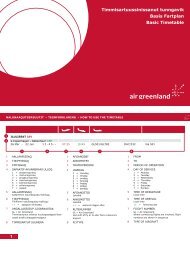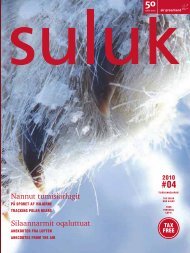Download PDF - Air Greenland
Download PDF - Air Greenland
Download PDF - Air Greenland
You also want an ePaper? Increase the reach of your titles
YUMPU automatically turns print PDFs into web optimized ePapers that Google loves.
The answer is found in the laryngeal<br />
pouch that the dovekie develops below<br />
its beak before the breeding season.<br />
This enables it, pelican-wise, to carry up<br />
to 4,000 small water fleas at a time.<br />
Thus the dovekie is the only species of<br />
bird in the North Atlantic which has<br />
adapted to a source of food where<br />
there is no competition from other birds.<br />
The nearest competitors can be found<br />
in fish and the large baleen whales.<br />
Nevertheless, the most impressive<br />
characteristic of the dovekie is not its<br />
adaptation to a specific food; it is the<br />
number of birds that are found in a<br />
dovekie colony.<br />
Millions of birds<br />
The dovekie is truly a real arctic breeding<br />
bird. In <strong>Greenland</strong>, the species is<br />
found in enormous numbers in Qaanaaq<br />
in North <strong>Greenland</strong>, the Ittoqqortoormiit<br />
region of North East <strong>Greenland</strong><br />
and in small individual colonies in the<br />
Upernavik and Disko Bay regions. In<br />
addition to <strong>Greenland</strong>, the dovekie is<br />
widespread on Svalbard and on some<br />
Suluk # 02•2005 34<br />
of the northern Siberian islands, although<br />
it is not found in such large numbers as<br />
<strong>Greenland</strong> anywhere else in the world.<br />
The precise number of birds found in<br />
colonies in <strong>Greenland</strong> is difficult to<br />
determine because the dovekie builds<br />
its nest in loose stones hidden in halfmetre<br />
deep cavities. The enormous<br />
numbers of birds which congregate in<br />
the same place mean that it is not possible<br />
to use the usual method of counting<br />
in the case of the dovekie.<br />
Bird researchers estimate than between<br />
20 and 40 million dovekie pairs<br />
breed in the Qaanaaq region and that<br />
the colonies in the Ittoqqortoormiit<br />
region probably consist of between 5 –<br />
10 million pairs. This means that more<br />
than 80% of the world's population of<br />
dovekies can be found in <strong>Greenland</strong><br />
and that, with these numbers, the species<br />
is one of the world's most abundant<br />
seabirds.<br />
Although the dovekie is not large, it<br />
is an important element in the ocean's<br />
ecosystem because of its enormous<br />
numbers. Calculations have shown that<br />
while the chicks are being fed, the<br />
parent birds in a colony with 100,000<br />
pairs will collect more than 5 tons of<br />
food from the sea. Since the dovekie<br />
spends a considerable time in and<br />
around the colony, a great part of this<br />
food, in the form of droppings, will be<br />
deposited on land around the colony.<br />
The usual natural cycle involves transport<br />
of nutrients from land to sea. But<br />
in the case of the dovekie, this transport<br />
takes place in the opposite direction:<br />
from the sea to the land.<br />
■ Although the dovekie is just a small bird, it has a<br />
loud voice. When several thousand birds take to<br />
air at the same time the noise is deafening.<br />
■ Appaliarsuk mikigaluarluni nipituumik<br />
qarlortarpoq. Appaliarsuit 1000-it arlallit<br />
ataatsikkut tingisut nipaat qoqernaannartarpoq.<br />
■ På trods af at søkongen kun er en lille fugl, har<br />
den er kraftig stemme. Lyden af adskillige tusinde<br />
fugle går i luften samtidigt er øredøvende.











